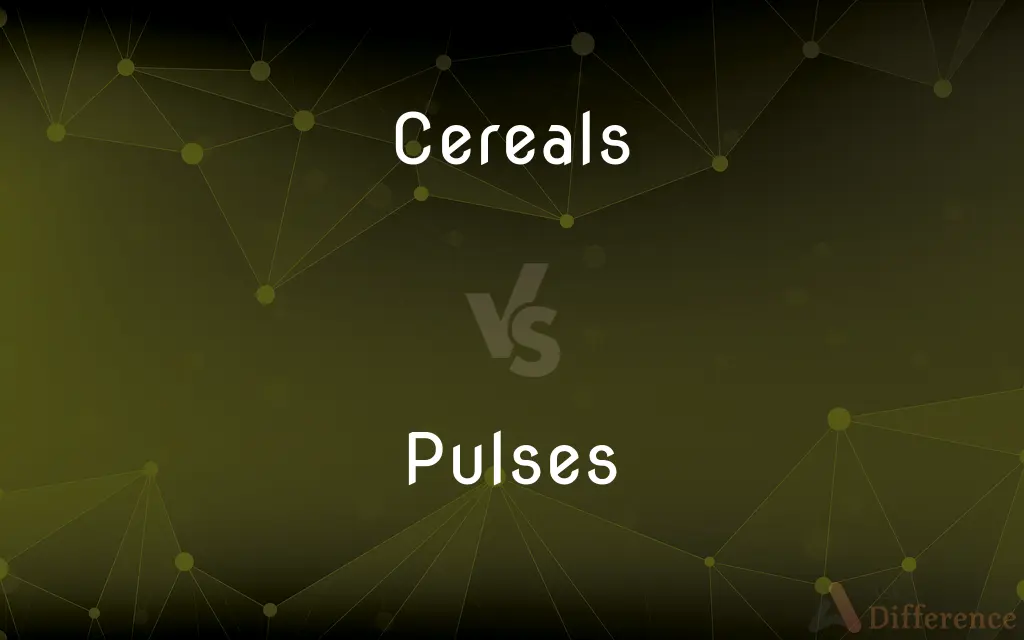Cereals vs. Pulses — What's the Difference?
By Tayyaba Rehman — Published on November 3, 2023
Cereals are grassy plants producing edible grains like wheat or rice, while Pulses are leguminous crops harvested for their dry seeds, like lentils or chickpeas.

Difference Between Cereals and Pulses
Table of Contents
ADVERTISEMENT
Key Differences
Cereals are primarily cultivated for their grains. Originating from the grass family, these plants include staples such as rice, wheat, maize, barley, and oats. Their grains are a major food source worldwide, providing essential nutrients and calories. Cereals form the base of various diets, being the mainstay for bread, porridge, and many other dishes.
Pulses, on the other hand, are the seeds harvested from the pods of leguminous plants. Examples include lentils, chickpeas, beans, and peas. These are high in protein and fiber, making them particularly important for vegetarian and vegan diets. Unlike Cereals, Pulses don't come from grassy plants; instead, they're derived from legumes.
The cultivation methods for Cereals and Pulses also show variation. While Cereals are grown primarily for their grains, Pulses focus on producing mature seeds. It's interesting to note that both Cereals and Pulses play significant roles in sustainable agriculture. They enrich soil fertility, especially Pulses, which fix nitrogen in the soil.
In culinary practices, the application of Cereals and Pulses is vast. Cereals are often milled into flour for bread, pastas, and breakfast cereals. Pulses, being rich in protein, can be the primary protein source in many dishes, especially in regions where meat consumption is low or for those who follow plant-based diets.
In summary, while both Cereals and Pulses are critical for human nutrition, Cereals are grains from grassy plants, and Pulses are mature seeds from leguminous plants.
ADVERTISEMENT
Comparison Chart
Source
Grassy plants.
Leguminous plants.
Examples
Wheat, rice, maize, oats.
Lentils, chickpeas, beans, peas.
Nutritional Highlight
Carbohydrates and some protein.
High protein and fiber.
Agricultural Contribution
Major staple crops globally.
Enhance soil fertility by fixing nitrogen.
Culinary Use
Milled into flour for bread, pasta, breakfast cereals.
Main protein source in dishes, especially in vegetarian diets.
Compare with Definitions
Cereals
Staple foods providing essential nutrients.
Cereals like rice and wheat are primary food sources globally.
Pulses
Rich in protein and dietary fiber.
Many vegetarians incorporate Pulses into their diet for protein.
Cereals
Edible grains produced by grassy plants.
Breakfast Cereals are a popular choice for a quick meal.
Pulses
Dry seeds harvested from leguminous plants.
Chickpeas and lentils are examples of Pulses.
Cereals
Include plants such as rice, wheat, and barley.
Cereals are extensively cultivated for their grains.
Pulses
Includes beans, lentils, and peas.
She added a variety of Pulses to her stew for added nutrition.
Cereals
Often milled into flour for various dishes.
She used cereal flour to bake fresh bread.
Pulses
The rhythmical throbbing of arteries produced by the regular contractions of the heart, especially as palpated at the wrist or in the neck.
Cereals
Major contributors to human caloric intake.
The world's population relies heavily on Cereals for energy.
Pulses
A regular or rhythmical beating.
Cereals
A grass such as wheat, oats, or corn, the starchy grains of which are used as food.
Pulses
A single beat or throb.
Cereals
The grain of such a grass.
Pulses
A brief sudden change in a normally constant quantity
A pulse of current.
A pulse of radiation.
Cereals
Any of several other plants or their edible seeds or fruit, such as buckwheat or certain species of amaranth.
Pulses
Any of a series of intermittent occurrences characterized by a brief sudden change in a quantity.
Cereals
A food prepared from any of these plants, especially a breakfast food made from commercially processed grain.
Pulses
The perceptible emotions or sentiments of a group of people
"a man who had ... his finger on the pulse of America" (Thomas P. O'Neill, Jr.).
Cereals
Consisting of or relating to grain or to a plant producing grain.
Pulses
The edible seeds of certain pod-bearing plants, such as lentils and chickpeas.
Cereals
Plural of cereal
Pulses
A plant yielding these seeds.
Pulses
To pulsate; beat
"The nation pulsed with music and proclamation, with rages and moral pretensions" (Lance Morrow).
Pulses
(Physics) To undergo a series of intermittent occurrences characterized by brief, sudden changes in a quantity.
Pulses
To chop in short bursts, as in a food processor
The cook pulsed the leeks and added some coriander.
Pulses
Plural of pulse
The electrifying beat sent pulses of energy through my body.
Pulses
Infl of pulse
Pulses
Not from grassy plants like Cereals.
Pulses are distinct from Cereals, originating from legumes.
Pulses
Important in sustainable agriculture.
Growing Pulses can enhance the nitrogen content in soil.
Common Curiosities
How do Pulses differ from Cereals?
Pulses are the dry seeds harvested from leguminous plants, like lentils or chickpeas.
What nutritional value do Pulses offer?
Pulses are high in protein and fiber, making them essential for many diets.
Are Cereals high in protein?
While Cereals provide some protein, they're primarily a source of carbohydrates.
What are Cereals?
Cereals are edible grains derived from grassy plants, such as wheat, rice, and maize.
Are oats and barley Cereals or Pulses?
Oats and barley are Cereals.
Which is a primary food source globally, Cereals or Pulses?
Cereals, such as rice and wheat, are major staple foods worldwide.
Do both Cereals and Pulses come from grassy plants?
Only Cereals come from grassy plants; Pulses are from leguminous plants.
How do Pulses contribute to sustainable agriculture?
Pulses can fix nitrogen in the soil, enhancing its fertility.
What are some dishes made from Cereals?
Bread, pasta, and breakfast cereals are all derived from Cereals.
Why are Pulses important for vegetarians?
Pulses, being rich in protein, are vital for vegetarians as a protein source.
Is rice a Pulse?
No, rice is a Cereal.
Are Cereals milled into flour?
Yes, many Cereals are milled into flour for culinary uses, like making bread.
Can you name a few common Pulses?
Lentils, chickpeas, beans, and peas are all examples of Pulses.
Do Cereals and Pulses grow in similar conditions?
While both can be cultivated in various climates, their specific requirements can differ based on the type.
Share Your Discovery

Previous Comparison
Smartwatch vs. Smart Bracelet
Next Comparison
Risk vs. RiskyAuthor Spotlight
Written by
Tayyaba RehmanTayyaba Rehman is a distinguished writer, currently serving as a primary contributor to askdifference.com. As a researcher in semantics and etymology, Tayyaba's passion for the complexity of languages and their distinctions has found a perfect home on the platform. Tayyaba delves into the intricacies of language, distinguishing between commonly confused words and phrases, thereby providing clarity for readers worldwide.














































